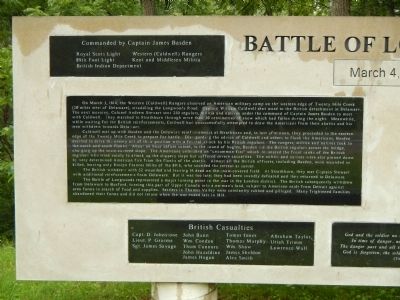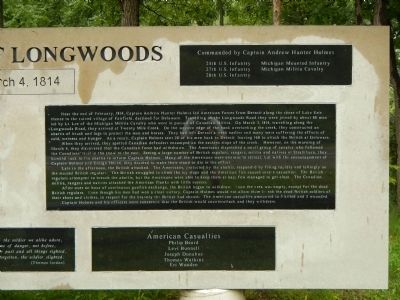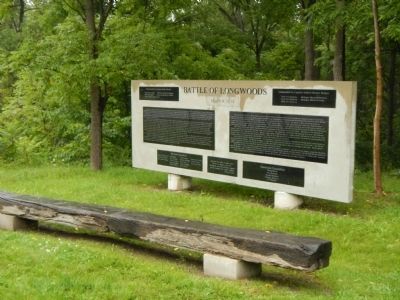Near Glencoe in Middlesex County, Ontario — Central Canada (North America)
Battle of Longwoods
March 4, 1814
Commanded by Captain James Basden
Royal Scots Light • Western (Caldwell) Rangers • 89th Foot Light • Kent and Middlesex Militia • British Indian Department
On March 3, 1814, the Western (Caldwell) Rangers observed an American military camp on the western edge of Twenty Mile Camp (20 miles west of Delaware), straddling the Longwood’s Road. Captain William Caldwell sent word to the British detachment in Delaware. The next morning, Colonel Andrew Stewart sent 250 regulars, militia and natives under the command of Captain James Basden to meet with Caldwell. They marched to Strathburn through more than 30 centimeters of snow which had fallen during the night. Meanwhile, while waiting for the British reinforcements, Caldwell had unsuccessfully attempted to draw the Americans from their abattis and his men withdrew towards Delaware.
Caldwell met up with Basden and the Delaware reinforcements at Strathburn and, in late afternoon, they proceeded to the eastern edge to the Twenty Mile Creek to prepare for battle. Disregarding the advice of Caldwell and others to flank the Americans, Basden decided to drive the enemy out of their position with a frontal attack by his British regulars. The rangers, militia and natives took to the north and south flanks. About an hour before sunset, to the sound of bugles, Basden lead the British regulars across the bridge charging up the snow-covered slope. The Americans unleashed an “uncommon fire” which decimated the front ranks of the British regulars who tried vainly to attack up the slippery slope but suffered severe casualties. The militia and natives were also pinned down by very determined American fire from the flanks of the abattis. Almost all the British officers, including Basden, were wounded or killed, leaving only Ensign Frances Miles of the 89th, who sounded the retreat at sunset.
The British withdrew with 52 wounded and leaving 16 dead on the snow-coverd field. At Strathburn, they met Captain Stewart with additional reinforcements from Delaware. But it was too late; they had been soundly defeated and they returned to Delaware.
The Battle of Longwoods represented a major turning point in the war in the London district. The British subsequently withdrew from Delaware to Burford, turning this part of Upper Canada into a no-man’s land, subject to American raids from Detroit against area farms in search of food and supplies. Settlers in Thames Valley were constantly robbed and pillaged. Many frightened families abandoned their farms and did not return when the war ended in late 1814.
British Casualties
Capt. D. Johnstone • Lieut. P. Graeme • John Bunn • Wm. Condon • Thom Connors • John Hazeldine • James Hogan • Tomas Jones • Thomas Murphy • Wm. Shaw • James Sheldon • Alex Smith • Abraham Taylor • Uriah Trimm • Lawrence Wall
The view from the American side (right side)
Commanded by Captain Andrew Hunter Holmes
24th U.S. Infantry • 27th U.S. Infantry • 28th U.S. Infantry • Michigan Mounted Infantry • Michigan Militia Cavalry
Near the end of February, 1814, Captain Andrew Hunter Holmes led American Forces from Detroit along the shore of Lake Erie thence to the ruined village of Fairfield, destined for Delaware. Traveling on the Longwoods Road they were joined by about 89 men led by Lt. Lee of the Michigan Militia Cavalry who were in pursuit of Canadian Militia. On March 3, 1814, traveling along the Longwoods Road, they arrived at Twenty Mile Creek, On the western edge of the bank overlooking the creek, they constructed an abattis of brush and logs to protect the men and horses. They had left Detroit a week earlier and many were suffering the effects of cold, wetness and hunger. As a result, Captain Holmes sent 20 of his men back to Detroit, leaving 160 to attack at Delaware.
When they arrived, they spotted Canadian defenders encamped on the eastern slope of the creek. However, on the morning of March 4, they discovered that the Canadian force had withdrawn. The Americans dispatched a small group of cavalry who followed the Canadians’ trail in the snow to the east. Seeing a large number of British regulars, rangers, militia and natives at Strathburn, they hurried back to the abattis to inform Captain Holmes. Many of the Americans were anxious to retreat, but with the encouragement of Captain Holmes and Ensign Heard, they decided to make their stand or die in the effort.
Late in the afternoon, the British attacked. The Americans, protected by the abattis, responded by firing rapidly and tellingly on the massed British regulars. The British struggled to climb the icy slope and the American fire caused severe casualties. The British regulars attempted to breach the abattis, but the Americans were able to keep them at bay; few managed to get close. The Canadian militia, rangers and natives attacked the Americans flanks with little success.
After over an hour of continuous gunfire exchange, the British began to withdraw. Soon the area was empty, except for the dead British regulars. Even though his men had won a clear victory, Captain Holmes would not allow then to rob the dead British soldiers of their shoes and clothes, in respect for the bravery the British had shown. The Americans casualties amounted to 5 killed and 3 wounded.
Captain Holmes and his officiers were concerned that the British would counterattack and they withdrew.
American Casualties
Philip Beard • Levi Bunnell • Joseph Donahoe • Thomas Watkins • Eri Wooden
In time of danger, not before,
The danger past and all things righted,
God is forgotten, the soldier slighted. —(Thomas Jordan)
Erected 2014.
Topics. This memorial is listed in this topic list: War of 1812. A significant historical month for this entry is February 1814.
Location. 42° 41.654′ N, 81° 42.339′ W. Marker is near Glencoe, Ontario, in Middlesex County. Memorial is on Longwoods Road (Provincial Highway 2) close to Pratt Siding Road, on the right when traveling east. Touch for map. Marker is at or near this postal address: 3219 Longwoods Road, Glencoe ON N0L, Canada. Touch for directions.
Other nearby markers. At least 4 other markers are within 21 kilometers of this marker, measured as the crow flies. Battle Hill (a few steps from this marker); Fairfield on the Thames / The Fairfield Mission (approx. 20.1 kilometers away); Fairfield (approx. 20.3 kilometers away); The Burning of Fairfield (approx. 20.3 kilometers away).
Also see . . . Battle Of The Longwoods. British troops converged on American soldiers encamped on Longwoods road (Hwy 2) at the large ravine east of Wardsville on March 4, 1814. The British with a combined force of 240 troops were joined with 28 natives. The Americans with only about 160 men had a protective defensive position on the west side of the steep ravine and repelled the attack, but then retreated back to Detroit fearing a larger British force would soon arrive. The battle lasted under two hours: the British suffered 14 killed and 52 wounded. (Submitted on October 29, 2014, by Barry Swackhamer of Brentwood, California.)
Credits. This page was last revised on July 30, 2020. It was originally submitted on October 29, 2014, by Barry Swackhamer of Brentwood, California. This page has been viewed 698 times since then and 48 times this year. Photos: 1, 2, 3. submitted on October 29, 2014, by Barry Swackhamer of Brentwood, California. • Andrew Ruppenstein was the editor who published this page.


